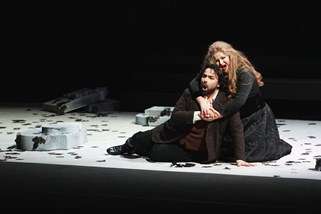|
Back
Pisa’s Towering Young Lucia Pisa
Teatro Verdi
01/18/2019 - & January 20, 2019
Gaetano Donizetti : Lucia di Lammermoor
Alessandro Luongo (Lord Enrico Ashton), Marigona Qerkezi (Lucia di Lammermoor), Alessandro Luciano (Sir Edgardo di Ravenswood), Carlos Natale (Lord Arturo Bucklaw), Andrea Comelli (Raimondo Bidebent), Valeria Tornatore (Alisa), Didier Pieri (Normanno)
Sascha Reckert (Glass Harmonica), Coro Ars Lyrica, Marco Bargagna (Chorus master), Orchestra della Toscana, Michael Güttler (Conductor)
Stefano Vizioli (Stage director), Allen Moyer (Sets), Michele Della Mea (Lighting), Massimo Poli (costumes)

A. Luciano, M. Qerkezi (© Imaginarium Creative Studio)
Operatic surprises do happen. I was fearing the worst when I noticed a change of cast for this Lucia di Lammermoor. The soprano originally programmed to sing the title role was stricken with laryngitis and Croatian soprano Marigona Qerkezi was to replace her.
I had heard the latter a year earlier in Barcelona in Rossini’s Il viaggio a Reims and was unimpressed. The prospect of a less than excellent singer conjuring Donizetti’s romantic heroine makes one uneasy. Luckily, the singer I’d heard in Barcelona was nowhere to be found. Despite minor reservations, Qerkezi proved an exceptional Lucia. Perhaps the smaller scale of Pisa’s Teatro Verdi, compared to Barcelona’s colossal Liceu, was the reason.
Stage director Stefano Vizioli chose to change the setting to the Victorian era, which was appropriate given the oppressive relation between Lord Enrico Ashton and his sister Lucia. This setting afforded visually appealing costumes, though drab colours dominated to suit the atmosphere. Throughout the entire opera, the park where Lucia meets Edgardo, as well as a wall representing the Ravenwood’s cemetry remained. This was a constant reminder of impending doom.
In her first aria, “Regnava nel silenzio,” Marigona Qerkezi was tentative. Her diction was unclear and the high notes were not solid. Least appealing was her tendency to sing sharp. In her duet with Edgardo (Alessandro Luciano), there was no chemistry. Perhaps even the contrary could be said. This may be understandable as Qerkezi arrived only days earlier, and had little time to rehearse or bond with her co-stars. Whlie Luciano was a paragon of clear Italian diction in the duet “Veranno a te,” the Croatian soprano sang mostly vowels.
Following that second scene in Act 1, a transformation happened and Qerkezi truly became Lucia. Her acting was more convincing, she moved more convincingly, and most importantly, she sang divinely. She was affecting when bullied by her brother; vulnerable when consoled by her priest Raimondo; and most importantly, in total vocal control while performing in the sextet. She was sublime in the Mad Scene. Her previously lazy diction became clear. She put the right emphasis on such crucial lines such as “Un’armonia celeste, di’, non ascolti?,” “Splendon le sacri faci” and “Vittima fu d’un crudel fratello.” Her high notes were dazzling, especially the final high note of that famous scene. Qerkezi is just 24 years old, an unheard age that was common in Donizetti’s times but extremely rare today. She seems to be an already polished singer in clear possession of what’s needed to become a major leading international voice.
The Mad Scene was intelligently staged. No bloodied dress was worn. This deliberate choice made Lucia’s madness more internal and hence more powerful. Brilliant lighting was used for Lucia’s appearance after having murdered her groom Arturo. The male chorus held lanterns against a darkened setting, creating a chiaroscuro effect. It was reminiscent of a Victorian-era painting of a ghost.
Alessandro Luciano was an appealing Edgardo who sang in true bel canto style. His timbre is pleasant, his diction impressive, but the solidity of the high notes was not always exemplary. His occasional use of falsetto high notes felt affected, as he obviously has the ability to sing them in full voice. His final aria “Tu che a Dio spiegasti l’ali” was beautifully sung, but this aria often falls flat as it is anti-climatic after Lucia’s Mad Scene.
Alessandro Luongo was a convincing Lord Enrico Ashton, vocally secure and most impressive dramatically. His irascible temperament was well-conveyed. He had at least as much stage presence as the romantic leads. The sacrificial bridegroom Arturo, Carlos Natale, has a small but beautiful tenor voice needed to contrast with Edgardo. His mannered acting and haughty style were convincing. Less appealing vocally were Raimondo, the priest, and Alisa, Lucia’s Lady in Waiting. Michael Güttler is a singer’s conductor, attentive to the needs of his singers. He adjusted the tempi as needed by the singers. The chorus was well prepared by Chorus Master Marco Bargagna.
Ossama el Naggar
|